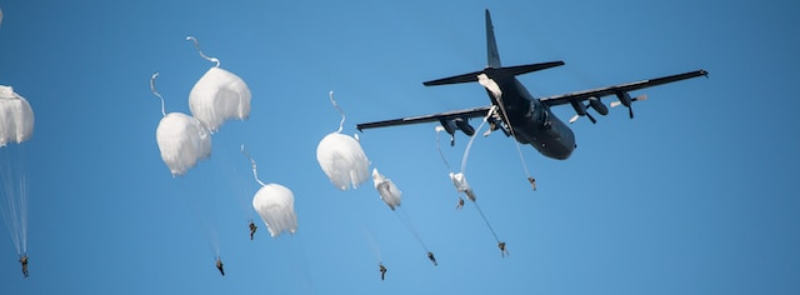
When It Occurs
Every August 16th
Timeline
Days Passed (873)
# Hashtags
#NationalAirborneDay #FirstParachuteJump
National Airborne Day, observed on August 16th, pays tribute to the military's airborne divisions within the Armed Forces. On August 16, 1940, history was made with the first official Army parachute jump at Ft. Benning, Georgia. This successful jump validated the pioneering concept of deploying U.S. ground combat forces by parachute, positioning them behind battle lines. These elite sky soldiers epitomize some of the most distinguished and extensively trained units in the United States Army. #NationalAirborneDay
Origins and History
The history of National Airborne Day is rooted in the development of airborne forces and their pivotal role in military history:
- First Parachute Jump: On August 16, 1940, the U.S. Army conducted its first official parachute jump at Fort Benning, Georgia. This successful jump demonstrated the feasibility of airborne operations and led to the formation of the Parachute Test Platoon.
- Formation of Airborne Units: Following the initial tests, the U.S. Army established its first airborne units, including the 82nd and 101st Airborne Divisions, which became famous for their roles in World War II.
- Legislation: In 2001, President George W. Bush signed a congressional resolution designating August 16th as National Airborne Day to honor the contributions of airborne forces.
The Significance of Airborne Forces
Airborne forces have played a critical role in U.S. military operations for several reasons:
- Strategic Mobility: Paratroopers can be rapidly deployed behind enemy lines, providing a strategic advantage by disrupting enemy operations and securing key positions.
- Bravery and Skill: Airborne operations require exceptional bravery and skill, as paratroopers face significant risks during jumps and subsequent combat operations.
- Historical Impact: Airborne forces have been instrumental in several major conflicts, including World War II, the Korean War, the Vietnam War, and various operations in the Middle East.
Ways to Observe National Airborne Day
There are many meaningful ways to observe National Airborne Day and honor the contributions of airborne forces:
- Learn About Airborne History: Take the time to learn about the history and achievements of U.S. airborne forces. Read books, watch documentaries, or explore online resources that provide insights into their operations and contributions.
- Visit Military Museums: Visit military museums or memorials that feature exhibits on airborne forces. The Airborne and Special Operations Museum in Fayetteville, North Carolina, offers extensive exhibits on the history of airborne operations.
- Attend Commemorative Events: Participate in events and ceremonies held to honor airborne forces. These may include parades, reenactments, and speeches by veterans and military officials.
- Support Veterans: Show support for airborne veterans by contributing to organizations that provide assistance and resources to veterans and their families. Volunteering or donating to these organizations can make a meaningful impact.
- Share Stories: Share stories and information about airborne forces on social media using the hashtag #NationalAirborneDay. Highlight the bravery and achievements of paratroopers to raise awareness and appreciation.
- Fly the Flag: Display the American flag to honor the service and sacrifice of airborne forces. Encourage others to do the same in a show of solidarity and respect.
- Military Workouts: Participate in or organize a military-style workout or training session inspired by the rigorous physical training of paratroopers. This can be a way to honor their dedication and physical prowess.
Notable Airborne Operations
Airborne forces have been involved in several significant military operations:
- D-Day (Operation Overlord): On June 6, 1944, airborne forces from the 82nd and 101st Airborne Divisions parachuted into Normandy, France, ahead of the main Allied invasion force. Their mission was to secure key positions and disrupt German defenses, playing a crucial role in the success of D-Day.
- Operation Market Garden: In September 1944, Allied airborne forces, including the 101st and 82nd Airborne Divisions, conducted a large-scale operation to secure bridges in the Netherlands. Although the operation faced challenges, it demonstrated the strategic importance of airborne troops.
- Operation Just Cause: In December 1989, U.S. airborne forces played a key role in the invasion of Panama, aimed at capturing Panamanian leader Manuel Noriega and restoring democratic governance.
Fun Facts About Airborne Forces
- Airborne Divisions: The U.S. Army currently has two active airborne divisions: the 82nd Airborne Division, based at Fort Bragg, North Carolina, and the 173rd Airborne Brigade, based in Italy.
- Distinctive Insignia: Airborne troops are known for their distinctive insignia, including the airborne tab and parachutist badge, which signify their airborne qualifications.
- Paratrooper Training: Airborne training is rigorous and includes the Basic Airborne Course at Fort Benning, where soldiers learn the skills needed for parachute operations, including aircraft exits, mid-air body position, and parachute landing falls.
Conclusion
National Airborne Day is a significant occasion to honor the bravery, skill, and contributions of U.S. airborne forces. Whether through learning about their history, attending commemorative events, or supporting veterans, this day offers numerous ways to show appreciation for the paratroopers who have played a crucial role in defending freedom. On August 16th, take the time to reflect on the sacrifices and achievements of airborne forces and celebrate their enduring legacy in the U.S. military.


